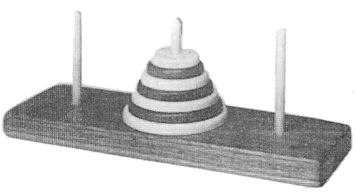
The French mathematician Edouard Lucas invented this puzzle in 1883 and called it La Tour d'Hanoi (The Tower of Hanoi). Sometimes the puzzle has been called The Tower of Brahma, and a fanciful legend (perhaps invented by Lucas) is told about the tower.
...in the temple of Benares, where the center of the world lay, there was a brass plate on which stood three diamond needles. While creating the world, God placed 64 gold disks, from large to small, on one of these needles... The priests, in accordance with the laws of Brahma, remove one disk at a time to one of the other needles. The disk on top of which the priest places his, can never be smaller than the one going on top of it... only one disk at a time can be moved. Once the tower has been transferred from one needle to another, everything will turn to dust and the world come to an end with a big bang.
This legend is quoted from Jerry Slocum & Jack Botermans, New Book of Puzzles, New York: W.H. Freeman & Co., 1992, pages 104-105, who also say:
Not to worry though. To move these 64 disks from one needle to the other needle 18,446,744,073,709,551,615 movements are needed. So you can sleep peacefully.
Pieter van Delf & Jack Botermans (Creative Puzzles of the World, New York: Harry N. Abrams, Inc., 1978, page 175) indicate that in mathematical terms, for this puzzle the number of moves required to transfer just 3 disks is 7 moves or (2x2x2-1). With 64 disks the priests would have required (2 to the 64th power minus one) moves. It is estimated that at one move every second, this would take nearly 6 billion centuries!
The Museum's copy of this puzzle was purchased in 1975 from World Wide Games, Delaware, Ohio. Made of a number of natural woods, the base is 22.3cm long x 7.6cm wide x 1.6cm thick. The pegs are 7.6cm long x .6cm in diameter. Each of the 7 disks range in size from 3cm to 6.7cm in diameter and are .6cm thick. Both references cited above offer plans for making this puzzle.
The object of the puzzle is to move all of the discs from the center peg to one of the outside pegs, always placing a smaller disc on top of a larger disc, never a larger disc on a smaller disc. Only one disc may be moved at a time.
Here is the solution for a set such as the one in the collection with 7 discs. With a set such as this, with discs of light wood and dark wood, one constant in moving the discs is to always alternate the discs, never putting a dark one on a dark one, or a light one on a light one.
 Now start the puzzle with all 7 discs on the center peg as illustrated in the photogrph to the right. Start with all seven discs on the center peg. Move the smallest disc first to the right peg and move the second disc to the left peg. Then move the smallest disc to the left peg (on top of second disc) and move the third disc to the right peg. Then move the smallest disc to the center peg and move the second disc from the left peg to the right peg. This is the sequence to follow with the smallest disc throughout the working of the puzzle: right, left, then the center in between each move of the smallest available disc.
Now start the puzzle with all 7 discs on the center peg as illustrated in the photogrph to the right. Start with all seven discs on the center peg. Move the smallest disc first to the right peg and move the second disc to the left peg. Then move the smallest disc to the left peg (on top of second disc) and move the third disc to the right peg. Then move the smallest disc to the center peg and move the second disc from the left peg to the right peg. This is the sequence to follow with the smallest disc throughout the working of the puzzle: right, left, then the center in between each move of the smallest available disc.

A related puzzle for young children includes only one peg, but follows the same principal regarding the correct placement of disks. If large disks are placed on smaller ones, the egg shaped outer pieces will not fit over the inner section. This puzzle was donated to the Museum in the 1970s. It is thought to have been made by
Playschool, Inc.
NOTE: This page was originally created and posted on the Web on October 6, 1997. Subsequently it has been modified and periodically updated. Last update December 2, 2010